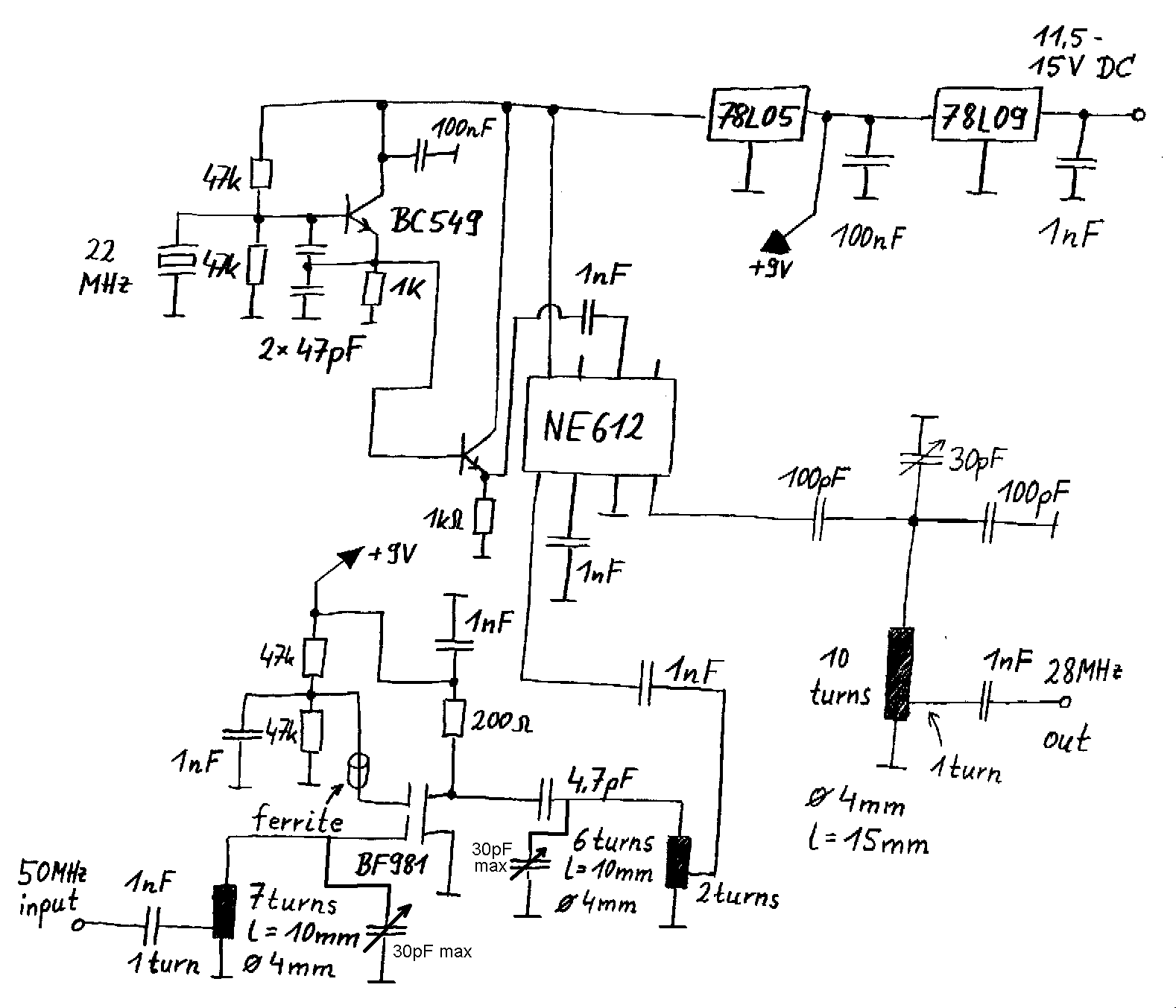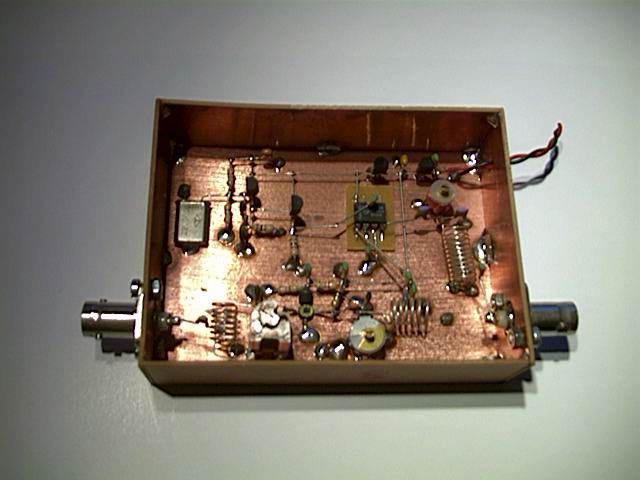
| english
Hello folks, if you speek english than this left column is for you. A picture of the circuit and a schematic diagram can be found below this description. The concept of the RX converter is quite simple and nothing really new. The local oscillator is a standart colpitts crystal oscillator producing the 22MHz LO signal. This signal is fed into the traditional NE612 double balanced mixer from Philips. (The NE602 can also be used without any changes.) In order to have a real good sensitivity the RX signal is preamplified by a dualgate MOSFET preamplifier. I have used a BF960 but a BF981 or similar will also work well. (I suggest to use a ferrite beat on the drain 2 pin in order to avoid problems with RF oscillation of the LNA.) Well thats basicly it, the DC input voltage (11.5 to 15 Volts) is regulated twice to have the 9Volts for the LNA and the 5Volts for the Mixer and the local oscillator. Calibration is fairly straight forward. Connect the converter to your 28MHz receiver (make sure not to transmit into the converter) and adjust all trimmers for maximum noise level. If you have a 50MHz signal available that you can use for calibration than its even easier, simpliy adjust all trimmers for maximum signal strength. If you should not find a resonace it may be necessary to add or remove a turn of the coil. But normally this should not be necessary. One thing: There are two high-Q resonace filters to make sure that the image frequency and signals on 28 MHz are well surpressed. However if you have very strong signals on 28MHz or on 6MHz (the 49m radio broadcast band) then you may hear this signals on 28MHz after the converter. So note that if you hear something it is not necessarily your first 50MHz signal! Have fun with the converter. If you have troubles to get it working just send me a mail and I will try to give you a hand. |
deutsch
Hallo, wenn Ihr deutsch sprecht dann seit Ihr hier in der rechten Spalte genau richtig. Ein Bild der Schaltung und den Schaltplan findet Ihr unterhalt dieser Beschreibung. Das Konzept des Konverters ist recht einfach und nicht wirklich neu. Der Lokaloszillator ist ein standart Colpitts Quarz-Oszillator. Er produziert das 22MHz LO Signal. Dieses Signal wird in den altbekannten doppelt balancierten Mischer NE612 von Philips gegeben. (Ein NE 602 kann als Austauschtyp ebenso verwendet werden.) Um eine gute Empfangsempfindlichkeit zu bekommen wird das Empfangssignal erst mal von einem Dualgate MOSFET verstärkt. Ich haben einen BF960 verwendet aber ein BF981 oder etwas ähnliches wird genauso funktionieren. (Ich empfehle die Ferrit Perle über dem Drain2 Beinchen um hochfrequente Oszillationen zu vermeiden.) So, das war's schon fast, die Betriebsspannung (11.5 bis 15 Volt) werden zweimal runtergeregelt um die 9Volt für den Vorverstärker und die 5Volt für den Mischer und den Oszillator zu erzeugen. Der Abgleich ist ziemlich einfach. Den Konverter an den 28 MHz Empfänger anschließen (nicht reinsenden!) und alle Trimmer auf Rauschmaximum einstellen. Wenn ein 50MHz Signal zur verfügung steht ist die Sache noch einfacher, einfach alle Trimmer auf maximalen S-Meter Ausschlag einstellen. Wenn keine Resonanz gefunden werden kann ist es evtl. notwendig die Anzahl Spulenwindungen zu erhöhen bzw. zu reduzieren. Normalerweiße sollte das aber nicht notwendig sein. Eine Sache noch: Die Schaltung enthält zwei Filterstufen mit hoher Güte um zu verhindern daß Signale auf der Spiegelfrequenz oder 28MHz Signale an den Ausgang des Konverters gelangen. Wenn jedoch starke Signale auf 6MHz (dem 49m Rundfunkband) oder auf 28MHz anliegen ist es möglich daß diese Signale auf 28MHz zu hören sind. Nicht jedes Signal das man hört muß also das erste 50MHz Signal ein. Nun viel Spaß mit
dem Konverter. Bei Problemen mit dem Aufbau oder wenn irgendwas nicht funktioniert
bin ich gerne bereit zu helfen. Einfach eine kurze mail
an mich senden.
|


Have a look at
all the other stuff on my english homepage...
Viele andere Bauanleitungen
etc. gibt es auf meiner deutschen Homepage...